Introduction
In the construction industry, the Safety and well-being of workers are paramount. As the summer heat intensifies, the risk of heat-related illnesses becomes a significant concern. This article will delve into the crucial topic of Heat Illness Prevention in Construction. We will explore the importance of health, safety, and environmental (HSE) practices in reducing the risk of heat stress among workers. Understanding and implementing effective heat illness Prevention strategies is not just a regulatory requirement; it’s an ethical obligation to ensure the Safety of construction professionals.
Understanding Heat Illness
Heat illness encompasses a range of conditions that arise when the body cannot adequately cool itself. The most common types of heat-related illnesses include heat exhaustion and heat stroke, both of which can have severe implications for workers in high-temperature environments.
Types of Heat Illness
- Heat Exhaustion: Symptoms include heavy sweating, weakness, dizziness, nausea, and headache. It can escalate to heat stroke if not treated promptly.
- Heat Stroke: A severe medical emergency characterized by a body temperature exceeding 104°F (40°C), confusion, seizures, and potentially loss of consciousness. Immediate medical attention is critical.
- Heat Cramps: Painful muscle contractions often linked to extensive physical activity and dehydration.
Signs and Symptoms
Recognizing the symptoms of heat illness is crucial for prevention. Signs to watch for include excessive sweating, flushed skin, rapid heartbeat, confusion, and irritability. It’s essential for both workers and supervisors to be educated on these symptoms to take immediate action when necessary.
Regulatory Frameworks for Heat Illness Prevention
Various Regulations govern Workplace Safety, particularly concerning heat illness. The Occupational Safety and Health Administration (OSHA) has established guidelines that employers must follow to protect workers from heat-related Hazards.
osha Guidelines
OSHA recommends a comprehensive program for heat illness prevention, which includes:
- Providing water, rest, and shade for workers.
- Implementing a heat illness prevention plan that includes Training and education.
- Encouraging acclimatization for new workers or those returning after a break.
State Regulations
In addition to federal guidelines, several states have implemented their own regulations regarding heat illness prevention. For example, California’s Heat Illness Prevention Standard requires employers to take proactive measures to protect outdoor workers from heat exposure. It’s essential for construction companies to familiarize themselves with both federal and state regulations to ensure compliance.
Best Practices for Heat Illness Prevention in Construction
Implementing Best Practices for Heat Illness Prevention in Construction is vital for safeguarding workers. Here are some effective strategies:
1. Hydration
One of the most critical aspects of heat illness prevention is ensuring proper hydration. Workers should have access to cool, potable water at all times. It is recommended that workers drink water regularly, even if they do not feel thirsty, as thirst is not always an accurate indicator of hydration needs.
2. Rest Breaks
Frequent rest breaks are essential, particularly during peak heat hours. Establishing a schedule that allows for regular breaks in shaded or air-conditioned areas can help workers recover from heat exposure. Employers should encourage workers to take breaks as needed, without fear of reprimand.
3. Acclimatization
New workers or those returning after a long absence should gradually acclimatize to the heat. This process involves increasing exposure to hot conditions over a series of days, allowing the body to adjust. Employers should consider a 5 to 7-day acclimatization period for workers in high-temperature environments.
4. Training and Education
Educating workers about the signs and symptoms of heat illness is crucial. Training sessions should cover how to recognize heat stress in themselves and others, the importance of hydration, and the Procedures for seeking help. Regular refresher courses can reinforce these vital messages.
5. Monitoring Weather Conditions
Monitoring local weather forecasts and heat index levels can help employers make informed decisions about work schedules. Utilizing tools such as the National Weather Service’s heat index can provide valuable information to assess the risk of heat-related illnesses on the job site.
Case Studies: Successful Heat Illness Prevention
Real-world examples are invaluable in understanding the effectiveness of heat illness prevention strategies. Here are a couple of case studies illustrating successful implementations:
Case Study 1: ABC Construction
ABC Construction implemented a comprehensive heat illness prevention program after experiencing several heat-related incidents. They established a buddy system where workers were paired to monitor each other’s health and hydration levels. Additionally, they provided shaded rest areas and mandated scheduled breaks. As a result, the company reported a 50% decrease in heat-related incidents within one year.
Case Study 2: XYZ Demolition
XYZ Demolition faced challenges with worker fatigue during summer projects. They introduced a tiered work schedule that rotated employees through less strenuous tasks and incorporated additional hydration stations across the job site. Feedback from workers indicated improved morale and a reduction in heat-related complaints, demonstrating the program’s effectiveness.
Challenges in Implementing Heat Illness Prevention
While many employers recognize the importance of heat illness prevention, challenges often arise when implementing effective strategies. Here are some common obstacles:
Lack of Awareness
Many workers may not be aware of the risks associated with heat exposure or the symptoms of heat illness. This lack of awareness can lead to delayed action and increased risk. Employers must prioritize training and education to combat this issue.
Workplace Culture
A workplace culture that prioritizes productivity over safety can undermine heat illness prevention efforts. Some workers may feel pressured to work through heat stress symptoms, which can be dangerous. It’s essential for management to foster a culture that encourages safety and open communication about health concerns.
Resource Limitations
Implementing comprehensive heat illness prevention programs may require resources that some companies find difficult to allocate. However, investing in worker safety can lead to long-term Benefits, including reduced healthcare costs and improved productivity. Employers should view these programs as essential rather than optional.
Future Trends in Heat Illness Prevention
As the construction industry continues to evolve, so too do the strategies for preventing heat-related illnesses. Here are some emerging trends to watch:
Technology Integration
Advancements in technology offer new ways to monitor worker health and environmental conditions. Wearable devices that track body temperature, heart rate, and hydration levels can provide real-time data to supervisors, enabling timely interventions. Additionally, mobile applications can help workers access hydration reminders and safety information.
Focus on Mental Health
Recognizing the link between heat exposure and mental health is becoming increasingly important. High temperatures can exacerbate stress and fatigue, leading to decreased focus and increased risk of accidents. Future initiatives will likely emphasize the mental well-being of workers as part of heat illness prevention strategies.
Enhanced Training Programs
Training programs will continue to evolve, incorporating more interactive and engaging methods. Virtual reality (VR) and augmented reality (AR) may become tools for simulating heat exposure scenarios, allowing workers to practice recognition and response techniques in a safe Environment.
Conclusion
Heat illness prevention in construction is a critical aspect of Workplace Safety that cannot be overlooked. By understanding the risks, adhering to regulatory frameworks, implementing Best Practices, and learning from real-world case studies, employers can create a safer work environment for their teams. It’s essential to foster a culture of safety where workers feel empowered to prioritize their health and well-being. As we look to the future, embracing new technologies and focusing on mental health will further enhance our efforts in preventing heat-related illnesses. Let’s commit to protecting our workforce and ensuring that everyone returns home safely at the end of the day.


